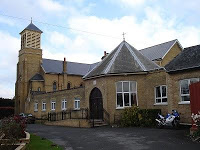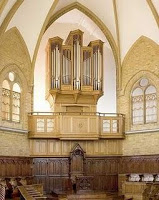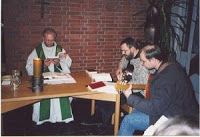
There has been a great deal of talk lately of the dismal state of music in the average parish, not just in the UK and the USA, but all over the Catholic world. Chant and polyphony, rather than being the staple diet, as VII stipulates, are the exception rather than the rule, as is the use of Latin. Choirs are rare, ‘folk’ music groups are the norm. The organ is the exception, the guitar is the norm.
When I make suggestions to clergy and parish musicians as to how they might go about improving music, such as using simple chants from the CMAA’s fantastic Parish Book of Chant, introducing a Gregorian Ordinary etc, even if it is De Angelis, the general response is “Oh that’s all gone now”, “That’s old hat now”, That’s too difficult for the people”, “The children won’t like it”, “We can’t worship in a language people don’t understand”, “We can’t do all that – we’re just an ordinary parish”.
Apparently, ordinary people are too stupid to learn a chant ordinary – they need a Gloria with a refrain, maybe the odd burst of clapping to keep the children amused, something tuneful that they can enjoy when they go to Mass, something they can hum. Am I alone in thinking that this is patronising to the People of God, that this is an insult to the intelligence of children, and indeed their parents? Am I also alone in thinking that the music we use in the Liturgy should be an offering to God, not chosen to suit the tastes of the people? Do children really enjoy clapping at Mass? Is that really to be regarded as the only way to keep them happy during the liturgy and enjoying Mass more? This is an insult to our youth – give them more credit! And as for understanding the texts we sing, does anybody actually know what Kum bay ya actually means?! Whenever I have seen and heard this musical, poetic and theological travesty of a hymn in use in a parish, I’ve never seen a parallel translation of the text!

I’d like to tell you about an ordinary parish in an ordinary town with an ordinary priest and an ordinary congregation. The Church in question is Our Layde and St Michael, Abergavenny. Abergavenny is a small market town in rural Wales, near the border with England. It has a population of around 14,500 and its Catholic Church is Grade II Listed (a British system of ensuring buildings of note are preserved and not tampered with). The town, which has a Catholic minority, is served by a monk of Belmont, Dom Thomas Regan, a Welshman, and the Church has a digital organ, a self-trained organist and an amateur choir drawn from the local population. Sounds remarkably ordinary doesn’t it?
However, this ordinary priest is actually a visionary man. Wherever Dom Thomas has served as a priest, he has left behind a legacy; of increased Mass attendance, of brand new churches built, of new church centres and halls funded and constructed, of schemes for local youth and for the elderly, of a deeper understanding of the faith, of excellent catechesis, of happier faithful and of excellent liturgy.
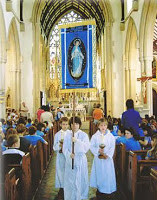
A typical Mass at Abergavenny involves a small-scale choral liturgy (the choir will sing a motet or a simple SATB Kyrie), Gregorian Chant, good, stable, quality hymnody in English, Latin (and Welsh!), fine vestments, a beautifully looked-after church, attention to every possible detail. Dom Thomas celebrates a Low Mass in the Usus Antiquior every Friday evening, and a regular Missa Cantata or even a Solemn High Mass on a frequent basis. Every so often the main Sunday Mass (Novus Ordo English/Latin) is replaced by a Solemn High Mass in the Usus Antiquior, with all propers provided by the amateur choir and all parts of the Ordinary sung by the faithful with a gusto that only the Welsh can deliver! The people don’t just accept this, they adore it! The Church is full, the faithful are happy and supportive, safe in the knowledge that they have a priest and musicians who serve them in the best possible way. The Sacred Liturgy is performed and prayed in the most solemn, dignified and prayerful way, and the choir is the envy of every ordinary parish in the UK, thanks to Dom Thomas, his faithful, dedicated and enthusiastic organist, Gwyn, and the loyal members of the Choir.

When I visit this beautiful town to see Thomas (who received me into the Church at Belmont Abbey when I was 18), I am always struck by how good everything is. I am also slightly saddened, and ask the question “If they can achieve all this here, then why not everywhere?” This is indeed an ordinary parish in an ordinary town, but what has been achieved is (sadly in many ways) extraordinary. I hope and pray that what happens in Abergavenny will become the norm in every ordinary parish the whole world over.
Nick Gale, June 2010
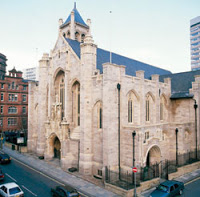 Now the Cathedral has a full-time music department, one of only three in Catholic cathedrals in
Now the Cathedral has a full-time music department, one of only three in Catholic cathedrals in 
